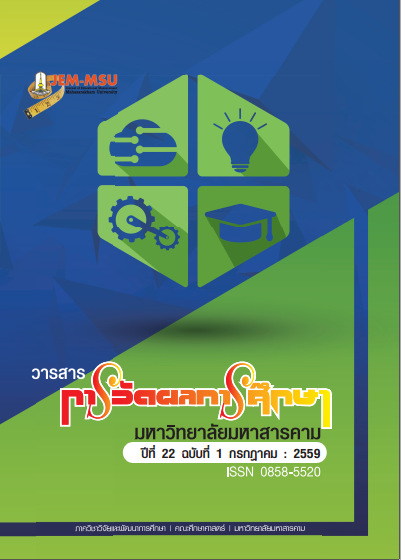The Development of Science Learning Activities by Using 7E Inquiry Cycle Cooperated with Gallery Walk of Matthayomsuksa 5 Students
Main Article Content
Abstract
The purposes of this research were: 1) to develop science learning activities by
using 7E inquiry cycle cooperated with gallery walk with the efficiency criterion of 75/75,
2) to compare the learning achievement and reasoning ability of Matthayomsuksa 5 students
between learning with 7E inquiry cycle cooperated with gallery walk and the traditional
learning approach, 3) to study the attitude toward science of a students who learned with
the 7E inquiry cycle cooperated with gallery walk, 4) to study the results of knowledge
sharing of the 7E inquiry cycle. The sample group was Matthayomsuksa 5 students which
selected by using purposive sampling technique. The research instruments were: 1) the 40
items of multiple choices of learning achievement test with the range of discrimination
value at 0.25 - 0.72 and reliability value at 0.90, 2) a subjective 5 items of reasoning ability
test with the range of difficulty value at 0.42 - 0.58; the range of discrimination value at 0.63
- 0.71 and reliability value at 0.89, 3) the 15 items of rating scale of attitude toward science
learning activity with the range of discrimination value at 0.45 - 0.84 and reliability value at
0.89. and 4) an unstructured observation form. The statistics were used for analyzing the
collected data were mean, standard deviation, percentage and Hotelling's T2 for testing
research hypothesis.
Research results revealed as the following:
1. The science learning activity by using 7E inquiry cycle cooperated with gallery
walk consist of the steps as following; 1) Elicitation; the teacher encourages students to
show their prior knowledge for discussion, 2) Engagement; the teacher encourages students
to challenge and present theirs ideas on the issue to be studied, 3) Exploration; the students
construct their plans, examine the issue, collect data for making a conclusion. The teacher
motivates students to take action by themselves, 4) Explanation; the teacher encourages
students to write their opinions and the reasons into the paper proof and stick around the
room. Each group shares their work sheet and others group gives them a suggestion. The
students consider the recommendations and improve their concept. The students make a
conclusion together, 5) Elaboration; the teacher promotes the students an opportunities to
transfer theirs knowledge explain the other situations, 6) Evaluation; the teacher evaluates
students with learning processes, 7) Extension; the teacher supports the students to connect
their knowledge to daily life. The efficiency of science learning activities by using the 7E
inquiry cycle cooperated with gallery walk was of 80.08/79.91.
2. The Matthayomsuksa 5 students who learned through the 7E Inquiry cycle
cooperated with gallery walk had a higher score on learning achievement and reasoning
ability than the students who learned through the traditional learning approach with the
statistically significance (P>0.05).
3. The students who learned through the 7E Inquiry cycle cooperated with
gallery walk had attitude toward science learning at the high level ( X = 4.36)
4. The Matthayomsuksa 5 students who learned by using the 7E Inquiry cycle
showed that they had more eager to learn and could discussed and shared their own ideas
with their friends.
Article Details
The content and information contained in the published article in the Journal of Educational Measurement Mahasarakham University represent the opinions and responsibilities of the authors directly. The editorial board of the journal is not necessarily in agreement with or responsible for any of the content.
The articles, data, content, images, etc. that have been published in the Journal of Educational Measurement Mahasarakham University are copyrighted by the journal. If any individual or organization wishes to reproduce or perform any actions involving the entirety or any part of the content, they must obtain written permission from the Journal of Educational Measurement Mahasarakham University.


